Table of Contents
What is a Column?
A column is a vertical structural element mainly carrying the compressive load and which length is higher than three-time to its least lateral dimension.
Column transfer load from the slab, floor slab, and beam to foundation or footing. In truss or frame structure, the inclined component carrying the compressive load is known as strut.
While a vertical compression element whose least lateral dimension is three times greater than its effective length is called a pedestal.
The column is an essential structural member whose failure causes the building may collapse. Different types of columns are used in the structure as per their need.
Essentially, Columns carry axial loads; therefore, they are designed for compressive load. Due to wind and snow, horizontal forces may cause column experience bending; consequently, they are designed for axial load and bending.
Usually, columns are made from different materials such as steel, concrete, stone, brick, timber that possess excellent compressive strength.
Usually, the column also bears bending moment cross-section axis one or both. In this article, we will know about the different types of columns used in the structure.
Purpose of Providing Column
Columns are used to transfer the axial compressive load and addition stresses that may lead to any failure.
We can construct small structures with masonry, but multistorey buildings can’t be built with the same method because masonry can’t bear heavy loads transmitted by structure.
Therefore columns are provided in multistorey buildings as an essential part of the frame structure.
Types of Columns
Based on the shape of the Cross-Section
Square or Rectangular Column
Square/rectangular columns are regularly used in building construction. They are suitable for square or rectangular shape rooms.
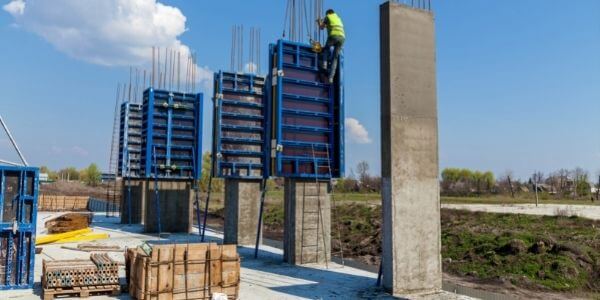
the construction process of these columns is more straight forward the circular column due to the easy installation of shutters.
It is easy to support shuttering of these columns to prevent them from collapsing because of concrete flowable form pressure. Furthermore, these shape columns are better and economical to construct.
Circular Column
Circular columns are suitable for piling and building elevation work regarding aesthetics.
Circular columns are provided with a minimum of six vertical reinforcements, and these columns perform betters against bending in comparison to square/rectangular columns.
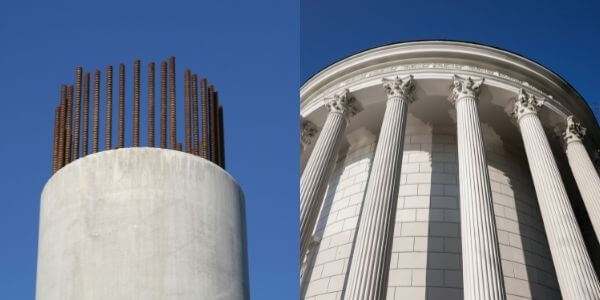
We prefer circular columns to avoid sharp edges as the square column. These columns are suitable for auditorium and assembly area sit-out, which require significant space for movement without hindrance.
Also, you can find these types of columns in pillars of bridges where high compressive strength is needed.
L- Type Column:-
L type of columns have the same rectangular or square column features and are suitable for the boundary wall corners. These columns are rarely practised.

T- Type Column
These shape columns have the same rectangular or square column features are used in bridge construction and as per design need.
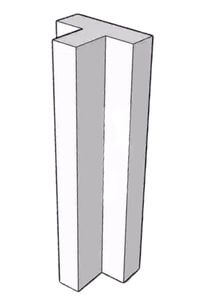
V- Type Column:-
As the name indicates, this column resembles a V shape and is suitable for a trapezoidal shape room and aesthetic purpose. It needs more concrete in comparison to other shape columns.
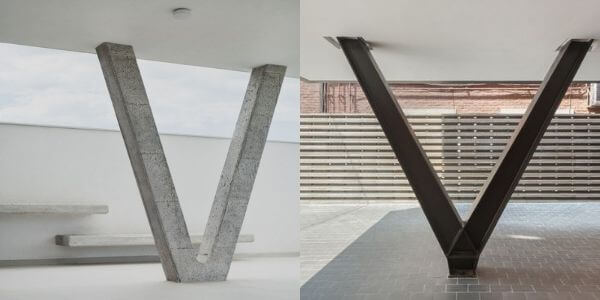
Hexagon Column:-
They are modified columns with six sides and provide a better pictorial view, usually preferred for elevation.
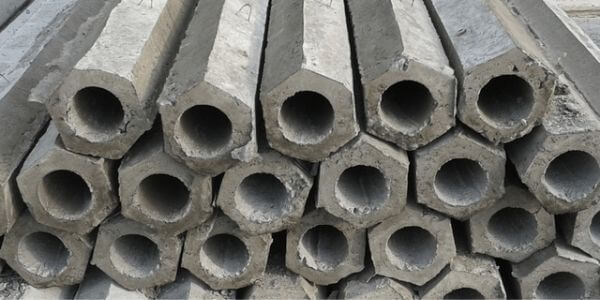
These shapes columns offer an elegant look to the building, primarily used in the cinema hall, auditoriums, verandah, etc.
Y – Type Column:-
Y-types of columns are primarily used in the construction of pillars for flyovers, bridges, etc.
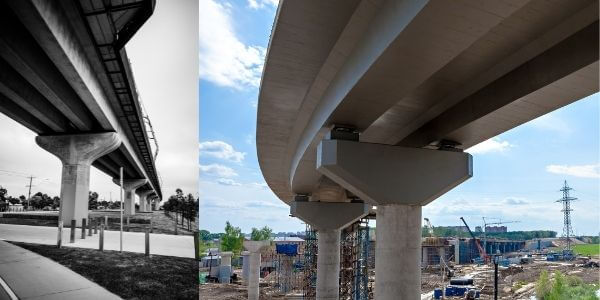
Y type Column with Arch
This column is similar to the y shape column except for sides or curved edges. Usually, they are used to construct pillars for flyovers and bridges to bear the heavy load with limited space.

Based On Reinforcement Type
Based on the type of reinforcement provided, columns may be classified are as follows:-
Tied Column

This column is mainly made of reinforced concrete in which the main bare enclosed within nearly spaced stirrups/lateral ties is known as tied column.
If stirrups are spaced too far, it may lead to shear failure of the column and barreling between stirrups. As per the estimate, 95% columns of the building should be tied columns.
Spiral Column
This column is also made of reinforced concrete in which main bars are enclosed within closely spaced and continuously looped spiral reinforcement.
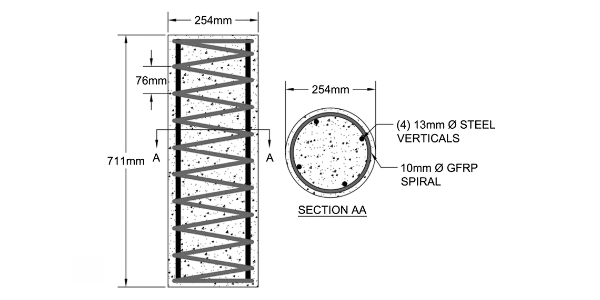
Spiral stirrup gives lateral controls (Poisson’s effect) and retard failure due to axial load (ductile).
Composite Column
In this type of column, longitudinal steel is provided in the form of steel pipe or section with or without main longitudinal bars is termed the composite column.

These types of columns are primarily used in steel structures(Trusses) to prevent steel from corrosion.
The composite column possesses sufficient strength with a reasonably small cross-section and performs better against fire.
Based On Loading Type
Axially loaded column
If the vertical compressive load acts on the column’s cross-section centre of gravity, it is called an axially loaded column.
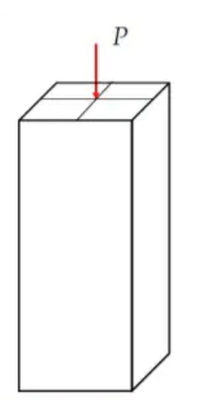
Since it is tough to coincide the load’s line of action to the column’s cross-section centre of gravity, these types of columns are limited in construction.
Examples of these columns are Internal columns in a multistorey building with symmetrical load from upper slabs from all sides.
Uniaxial Eccentric loaded column
Suppose the vertical compressive load’s line of action doesn’t coincide with the column’s cross-section centre of gravity and acts eccentrically either on the X-axis or y-axis. In that case, it is referred to as a uniaxially eccentrically loaded column.

Such as edge column in which column rigidly connected with beam only from one side is the example of uniaxial loading.
Biaxial Eccentric loaded column
Suppose the vertical compressive load’s line of action doesn’t coincide with the column’s cross-section centre of gravity and doesn’t either on the X-axis or y-axis. In such a case, it is known as a biaxially eccentrically loaded column.

Columns in the corner with the rigidly connected beam at the right angle on the column’s top are examples of the biaxially eccentrically loaded column.
Based On The Slenderness Ratio
Short Column
If the column’s effective length to its least lateral dimension ratio is less than 12, it is termed the short column. These columns fail due to the crushing of concrete.

Long Column
If the column’s effective length to its least lateral dimension ratio passes 12, it is termed the long column. These columns fail due to bending or buckling.

These columns are weaker in comparison to short columns for the same cross-section area and generally not favoured.
Based On Material For Construction
RCC Column
RCC columns consist of reinforced cement concrete in which steel bars are provided as reinforcement.
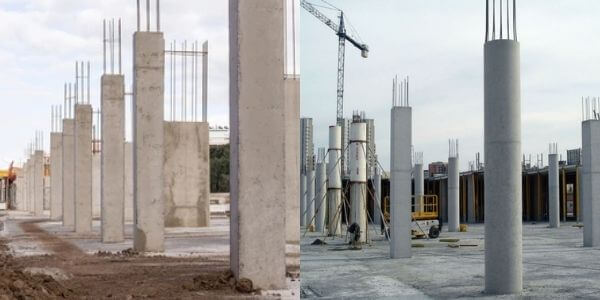
Primarily these columns are used for all types of buildings and other RCC structures such as bridges, tanks, etc.
Concrete performs better in compression but is weak in tension. Therefore it is reinforced to increase its performance under tension.
Steel Column
These columns are made of steel sections primarily used for heavy load in the construction of industrial buildings.
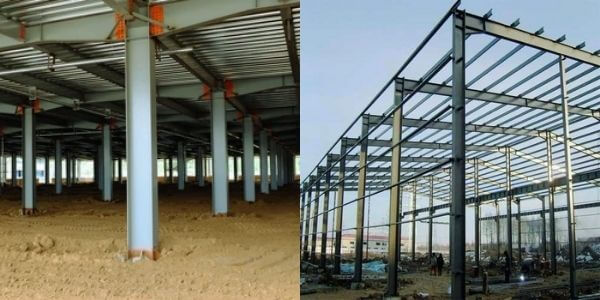
Steel structures are more robust, flexible, and durable in contrast to concrete structures. Steel columns are available in various shapes such as L, I, H, etc.
Timber Column
These columns are made of wood and are mainly used for light loads. Timber columns are generally used in wooden houses and small trusses and are also known as posts.
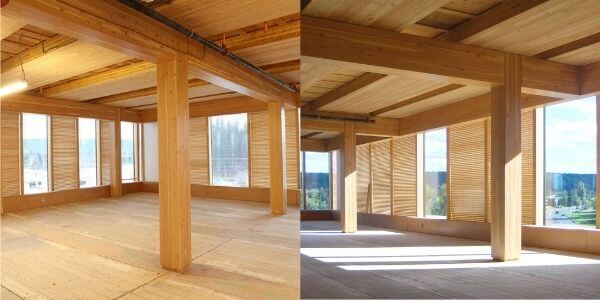
You can see these columns in old houses because this is the readily available construction material at that time.
It is a solid and durable material for construction but requires proper treatment. Seasoning of timber is performed to enhance its properties.
Masonry Column
Masonry columns are made of brick masonry mainly used for light loads and elevation purposes.
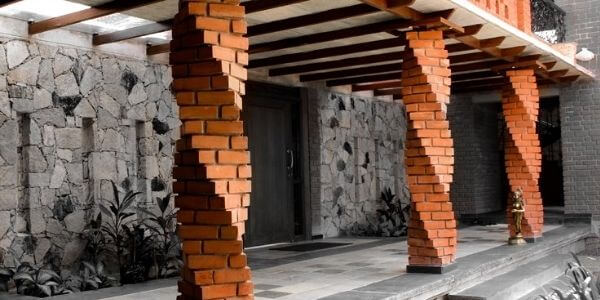
It has an essential role in giving support and stability to the masonry building. These columns may be constructed in different shapes such as circular, square or rectangular, etc.
Stone Column
These columns are made of stone and are mainly practised for appreciative purposes. These columns enhance the aesthetic appearance of the building and provide an elegant look.

Based On the Bracing of Frame
Braced Column
These columns are the parts of the frame structure, either braced or non-braced against sideway. Bracing gives lateral stability to the structure as a whole.
In building frames, bracing may be provided as shear walls or bracing form. Bracing helps to prevent relative transverse movement of the column’s lower and upper end.
Shear walls counter the lateral loads while the braced column acts against the gravity loads.
Unbraced column
These columns counter both gravity load and lateral load resulting in the reduction of the load-carrying capacity of the column.
Others Types
Prestressed Column
These columns are used as an extension of the RCC column when bending moment because of wind load, eccentric load, and frame action.
Prestressing helps to transform a cracked section into a non-cracked section and counters significant bending. Prestressing is suitable for precast and high slenderness ratio columns.
Stub Column/ Floating column / Linked Column:-
Generally, the column stands on a footing, but the stub column doesn’t have any foundation; it rests on a beam or slab.
The stub column is a redundant compression component. Stub column is suitable when the room has a large span, or different floors don’t have similar geometry.
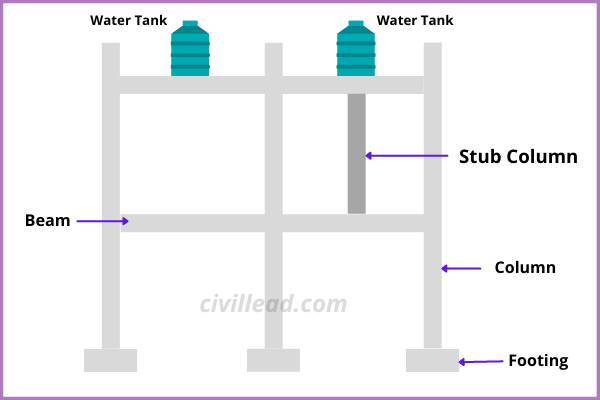
For example, there is a building with a capacity of 30 members and as per the member occupying the building water tank is designed.
But due to some reason, the same building is used by 60 members, and we have to provide another water tank for extra 30 members, but we have designed a building for only one water tank.
In such a case, to bear the load of the excess water tank, a stub column is provided beneath the tank, which rests either on a beam or slab.
Neck column:
The Neck column is a part of the column (any type) buried in the earth refers to the Neck column. The term neck column is used while constructing footings.
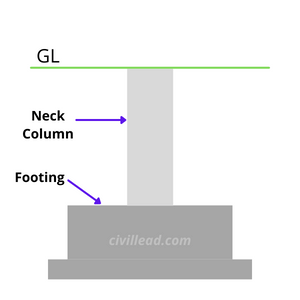
Greek And Roman Column
Roman and Greek architectures have followed four major column styles for their temples and buildings: Corinthian, Ionic, Tuscan, and Doric.
These columns are slightly tilted or lean, either left or right but look uniform and straight from a distance.
Also, Read
Load Calculation of Column, Beam, Wall and Slab
What is Lap Length? How to Calculate it? – Complete Guide
What is Development Length? – Complete Guide
What is Concrete Cover, Clear Cover and Nominal Cover